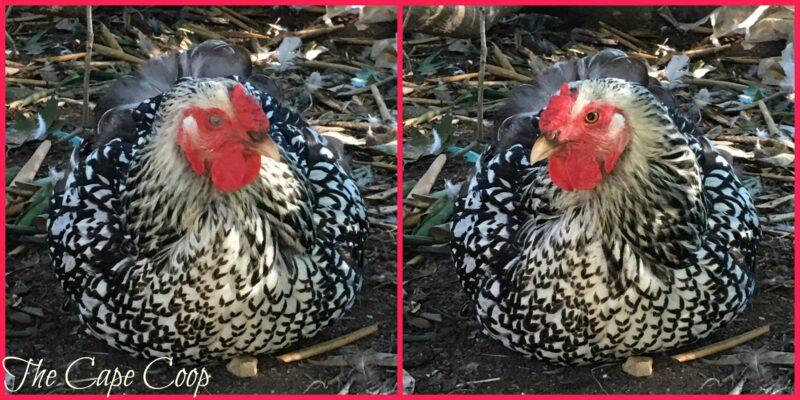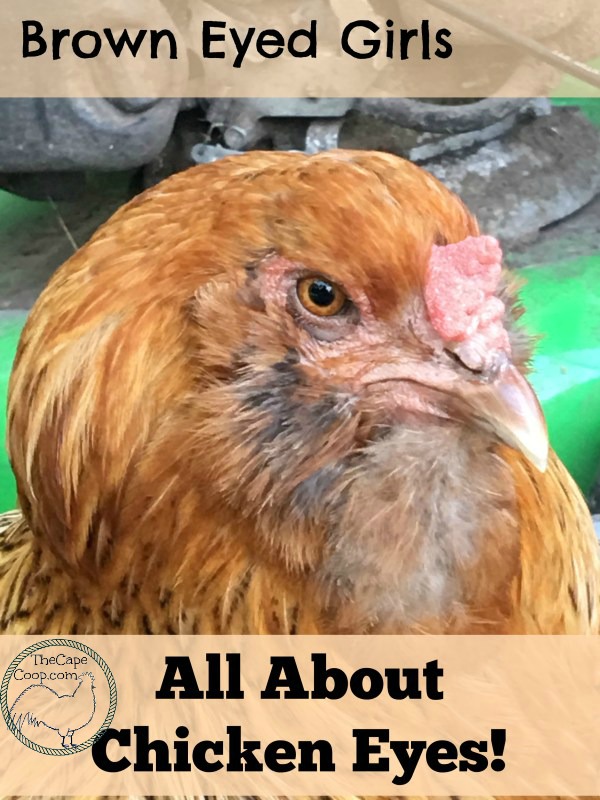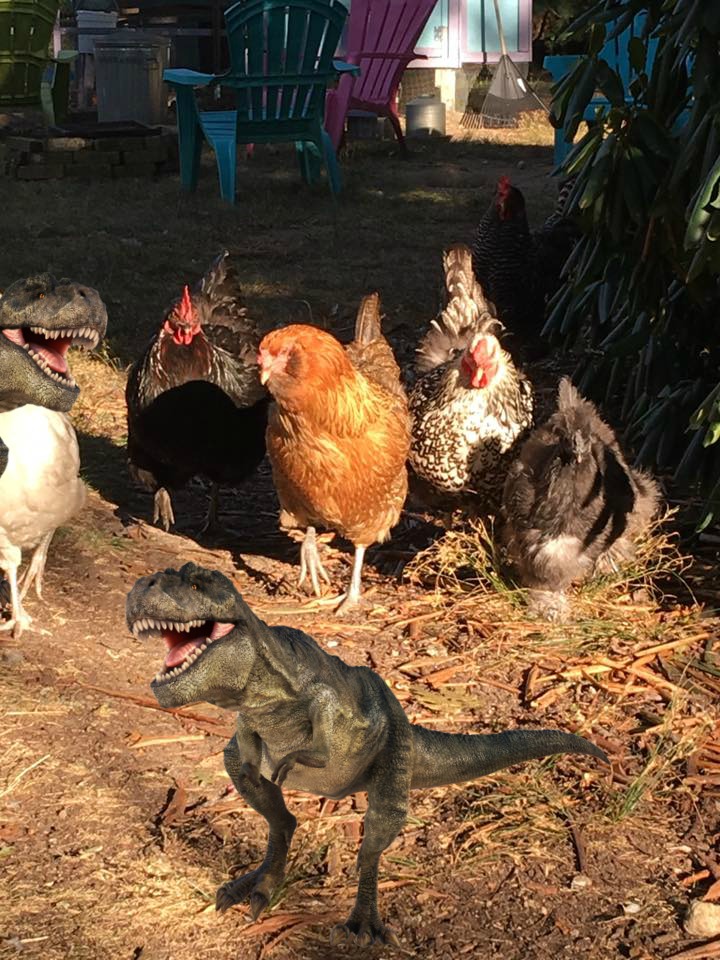---------------------------------------------------------
Chickens are fascinating creatures! They have complex little social lives which is part of what makes them so fun to watch, but they also have some fascinating physical characteristics too. Check out some of these interesting chicken eye facts!
There are five eye colors that are commonly found in chickens: gold, red, brown, black, & pink (albino). Their eye color is largely determined by genetics, but age, diet & disease can actually affect eye color.
Some diseases that can cause eye color changes include cancer (can turn the color to a grey-green) and Marek’s disease (eyes turn to a cloudy greyish color with dilated pupil)
When a hen is in her peak laying years it can wash out the colors from certain areas of her body – most notably legs, combs, wattles and even her eye color. This condition is known as “Hen’s Eye”
Young chicks have very dark eyes up until about 8 weeks of age
Chickens can use each eye independently to look at & process different things at once
Chickens have five cones
Chickens see in a wider range of colors than humans. Humans have three cones which allow us to see red, blue & green (with variations & combinations of these colors). Chickens have a fourth cone that allows them to see ultra violet light and a fifth “double cone” that helps them sense motion.
A mother hen can use the UV cone to literally see which of her chicks are healthiest by seeing the UV light reflected in their growing feathers. It is also believed they use this UV sight in selecting the healthiest, most colorful mate. Birds can find direction by looking at the sky, seeing the gradation of UV light, and “seeing” which way north is! Their motion sight helps them detect the smallest movements of insects and the presence of predators lurking in the grass.
Because chicken eyes are so sensitive to light & motion, using artificial lighting can lead to grumpiness and bullying because the undetectable (to humans) flickering of a light bulb can drive them crazy.
And three eyelids
In addition to upper & lower eyelids, chickens have a third eyelid called a nictitating eyelid that moves horizontally from front to back across the eye. This third eyelid is transparent so they can see through it. You can often see this eyelid when they are dust bathing, they want to be able to see, but want to keep dust out of their eyes. This eyelid has ruined many an otherwise awesome chicken photo! It causes the eye to look hazy in photos when closed (or partially closed)

They don’t need sight to sense daylight
Chickens have a pineal gland in their brains just under the skull that allows them to sense light even without seeing. The gland regulates their reproductive cycle (so effects egg laying). Their skull is thin enough the bright light can penetrate it and stimulate the gland. Even a completely blind chicken can “see” if it is daylight. This is why egg laying is so dependent on light – they need about 14-16 hours per day of light to stimulate the gland & lay an egg, so most times in short winter days egg production slows way down.
Fovea
Birds (and many mammals) have a structure called a fovea in their retinas that acts as an image enlarger. Chickens have two foveae, one is for distant vision, and one is for close up. The up close fovea is oval and sideways, and that’s why when you approach your chicken, they will often bob their heads and tilt their heads sideways to get the image of you into a clearer view. Chickens really can’t recognize flock members until they are within about 24 inches.
Very little night vision
Chickens can not see in the dark. Our retinas are made of rods & cones (cones help you see color, rods help you see at night). Chickens have very few rods. This is why they will go to roost about 30 minutes before dark, they know they need to find a safe place before the darkness sets in. The reason behind this lies in their ancestors, the dinosaurs. When dinosaurs roamed the earth most mammals became nocturnal for millions of years to survive, so they needed to see better in the dark. Dinosaurs did not develop night vision so their evolutionary descendants (most bird species) have pretty poor night vision.








Juno [not my real name]
Friday 22nd of January 2021
What part/parts of the chicken's brain controls the sight and smell
Liz
Friday 22nd of January 2021
The optic lobes (midbrain) would control the sight and the olfactory lobes (forebrain) control smell
Karen Baker
Tuesday 11th of August 2020
I’ve noticed my three 15 week old chicks have yellow where it should be white (sclera). They seem healthy otherwise and nothing else abnormal. Any thoughts on this? Can this be normal for their age? My other chickens in different runs are fine.
Liz
Tuesday 11th of August 2020
I'll start this by saying I am not a medical doctor of veterinarian, and this is my admittedly limited knowledge of chicken eye anatomy. If anyone has more info feel free to chime in! The sclera in a chicken is generally behind the sclerotic ring and not visible on the outside. The parts of the eye you can easily see are the pupil (the black center) and the iris (the colored part). The iris in chickens takes up the majority of the eye that you can see. Chickens don't have large "whites of the eye" like humans. Different breeds have different colored iris, and yellow can certainly be one of those colors. So that could be totally normal for those chickens. A very small "ring" around the iris is the conjunctiva and that should be a light pinkish color. If the conjunctiva get infected it could be enlarged and could turn red or even yellow. If you suspect an eye infection, it's best to consult a veterinarian for treatment options
Karen
Tuesday 11th of August 2020
I should add that I do my own fecals and they are negative. They eat organic chick starter from natures best. One is a buff Orpington and the other two are barred rock/ cuckoo maran mixes but all three have this so I don’t think it’s a breed thing. I am racking my brain trying to figure out what it could be.
Jacob
Friday 26th of June 2020
I just had to leave a comment because every paragraph blew my mind! SO interesting, thank you!
Liz
Friday 26th of June 2020
I'm glad you enjoyed it! :)
Janet Robinson
Wednesday 22nd of January 2020
What chicken breed is in the picture of this article (Brown Eyed Girls)?? I have two hens with this coloration and feathers next to their eyes and have no idea what they are....I rescued them last summer and have rehabilitated them. They're sweet, docile little girls and I'd love to know what they are! Thanks!
Liz
Saturday 25th of January 2020
If you are talking about the main photo - she is an Easter Egger. Easter Egger chickens come in lots of colors but always have beards and lay green, blue, or pink eggs. If your girls have clean faces with no beards and lay brown eggs but a similar color to my chicken they could be Rhode Island Reds or a production breed like Cinnamon Queen or Red Stars
Ashley
Thursday 8th of August 2019
Is it possible for two hens of the same breed and age to have two different eye colors? I have to black copper Marans hens and one has golden eyes and the other has black eyes. I never really noticed until I read this post, but now I’m intrigued!
Liz
Thursday 8th of August 2019
I am not positive, but I believe that not all chickens of the same breed have the same color eyes. This would be especially true if those chickens are not actually related to each other, as the eye color is mostly determined by genetics,not so much by breed. Super interesting!